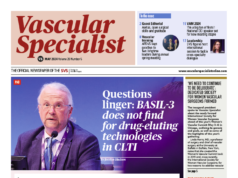
Patients undergoing cyanoacrylate glue closure for superficial venous disease reported higher periprocedural satisfaction than those who were treated via surgical stripping, data from a pair of randomised controlled trials (RCTs) assessing the VenaSeal system (Medtronic) reveal.
The modality also showed greater improvement in disease-specific quality-of-life compared to surgery or endothermal ablation. However, at 30 days participants in both the glue closure and strip-ping arms were similarly satisfied post-procedurally, the primary investigators told the Charing Cross (CX) International Symposium 2024 (23–25 April, London, UK) in the first-time release of results from the Spectrum Program trials.
Similarly, principal investigators Kathleen Gibson (Bellevue, United States) and Manj Gohel (Cambridge, United Kingdom) reported that in the RCT comparing the VenaSeal system to endothermal ablation, similar patient satisfaction was demonstrated between the two procedures. The results emerged yesterday afternoon in a Superficial Venous Controversies session at CX 2024.
The peri- and postprocedural primary endpoints were measured using the novel Venous Treatment Satisfaction Questionnaire (VenousTSQ) tool, Gohel said. Data from the RCTs also showed that VenaSeal performed similarly to both surgical stripping and endothermal ablation in terms of elimination of truncal reflux, the third primary endpoint. Results from the secondary endpoint measure of modified Aberdeen Varicose Vein Questionnaire (AVVQ) at 30 days showed trends in favour of the VenaSeal system compared to both surgical stripping and endothermal ablation.
Meanwhile, six-month effectiveness data showed that VenaSeal was non-inferior to surgical stripping, with similar anatomic closure rates (97.9% vs. 92.9%; p=0.00041). The equivalent measure was not tested between VenaSeal and endothermal ablation in the second RCT, but the trial investigators reported similar effectiveness in each arm.
The VenaSeal versus surgical stripping study included 88 patients, with 46 treated with the former and 42 the latter. In the second trial, VenaSeal (82) and endothermal ablation (81) combined for a total of 163 participants. All patients were Clinical, Etiological, Anatomical and Pathophysiological (CEAP) classification 2–5.
“This is an innovative study design, incorporating all of the usual elements we have seen in other trials, including quality of life measures and closure rates, but also includes new outcomes measures that are very patient focused on how they feel about their procedure and their outcomes,” Gibson said. “We are interested to see going forward whether we see any differences when we follow them out further.
“Participants were satisfied with their treatment. The VenaSeal patients—and all of the patients in general—had good quality-of-life improvements at 30 days. The VenaSeal patients had similar elimination of truncal reflux and closure rates compared to what are the worldwide gold standard. There was a low incidence of adverse events, and very similar to what we see in published literature. We did not find any new adverse events that had not been previously reported.”
Despite VenaSeal not meeting all of the patient-specific primary endpoints, “it is notable that there were tends towards advantages with VenaSeal and it performed comparably with our standards of care,” Gibson added.
The Spectrum Programme also contains a third single-arm study set to measure VenaSeal’s impact on venous leg ulcers (VLUs) in patients with C6 disease. It will measure time to ulcer healing through 12 months.
“This is a series of three studies, all with traditional outcome measures—a very robust safety assessment—but then with additional focus on patient satisfaction,” said Gohel. “The patients were similar, although there were some subtle differences.”












